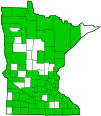redroot amaranth
(Amaranthus retroflexus)
Conservation • Wetland • Description • Habitat • Ecology • Use • Distribution • Taxonomy
Description |
||
Redroot amaranth is a 8″ to 60″ tall, erect, annual forb that rises from a shallow, fleshy, often reddish taproot. The stems are erect, stout, light green, reddish near the base, and usually branched above the middle. They are densely to moderately covered with short, soft hairs. They do not have spines at the nodes. The leaves are alternate, egg-shaped to diamond-shaped, ¾″ to 6″ long, and ⅜″ to 2¾″ wide. They are on leaf stalks that are half as long to as long as the blade. The leaf blades are tapered or narrowed at the base. They usually taper to a point at the tip with straight sides along the tip. Sometimes there is a small notch at the tip with a short, sharp, abrupt point in the notch. The upper surface is hairless or slightly hairy. The lower surface is hairy along the veins. The margins are untoothed and flat or slightly wavy. The inflorescence is a 2″ to 8″ long, dense, green, branched, elongated cluster (panicle) of numerous spikes at the end of the stem and branches, as well as smaller panicles or solitary spikes rising from the upper leaf axils. Male and female flowers are produced on the same plant. Female flowers have 5 white, petal-like sepals, no petals, and 3 stigmas. Male flowers have 5 white, petal-like sepals, no petals, and 4 or 5 stamens. The sepals are rounded at the tip. Each flower is subtended by one or more bracts that are sharply pointed and longer than the sepals. The pointed bracts give the inflorescence as bristly appearance. The fruit is an egg-shaped to elliptic, 1 ⁄16″ to ⅛″ long, membranous bladder (utricle) with a single seed. |
||
Height |
||
8″ to 60″ |
||
Flower Color |
||
Green to yellow |
||
Similar Species |
||
Green amaranth (Amaranthus hybridus) is a mostly hairless plant. The sepals are sharply pointed at the tip. |
||
Habitat |
||
Cultivated fields, pastures, yards, fencerows, roadside ditches, disturbed sites. |
||
Ecology |
||
Flowering |
||
July to September |
||
Pests and Diseases |
||
|
||
Use |
||
|
||
Distribution |
||||
|
Sources |
|||
| 4/29/2023 | ||||
Nativity |
||||
Native |
||||
Occurrence |
||||
Common |
||||
Taxonomy |
|||
| Kingdom | Plantae (Plants) | ||
| Division | Tracheophyta (Vascular Plants) | ||
| Subdivision | Spermatophytina (Seed Plants) | ||
| Class | Magnoliopsida (Dicots) | ||
| Superorder | Caryophyllanae | ||
Order |
Caryophyllales (Pinks, Cactuses, and Allies) | ||
Family |
Amaranthaceae (amaranths) | ||
| Subfamily | Amaranthoideae | ||
Genus |
Amaranthus (amaranths) | ||
Subgenus |
Amaranthus | ||
Subordinate Taxa |
|||
|
|||
Synonyms |
|||
Amaranthus retroflexus var. salicifolius |
|||
Common Names |
|||
careless weed common amaranth pigweed redroot red root amaranth red-root amaranth redroot amaranth redroot pigweed rough amaranth rough pigweed wild-beet amaranth |
|||
Glossary
Bract
Modified leaf at the base of a flower stalk, flower cluster, or inflorescence.
Panicle
A pyramidal inflorescence with a main stem and branches. Flowers on the lower, longer branches mature earlier than those on the shorter, upper ones.
Sepal
An outer floral leaf, usually green but sometimes colored, at the base of a flower.
Utricle
A small, dry, inflated, thin-walled, bladder-like fruit containing one seed.
Visitor Photos |
|||||
Share your photo of this plant. |
|||||
| This button not working for you? Simply email us at info@MinnesotaSeasons.com. Attach one or more photos and, if you like, a caption. |
|||||
|
|||||
MinnesotaSeasons.com Photos |
|||||
Plant |
|||||
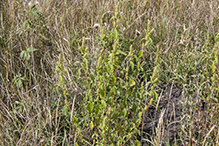 |
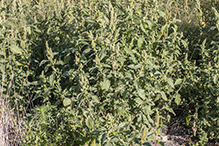 |
||||
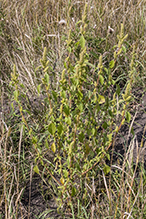 |
|||||
Inflorescence |
|||||
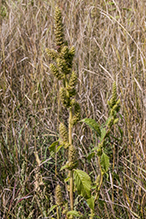 |
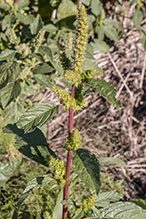 |
||||
Leaves |
|||||
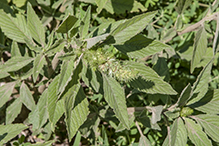 |
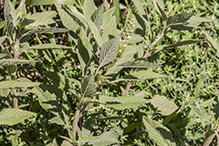 |
||||
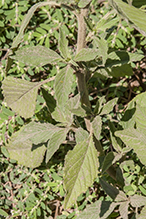 |
|||||

Slideshows |
||
| Amaranthus retroflexus Matt Lavin |
||

|
||
About
Native annual monoecious herb, with erect stems up to 1 m tall, fruit an circumcissle utricle (i.e., with a lid that pops off at maturity), in highly disturbed settings including crop fields, gardens, sides of roads and trails, in pastures, and around manure piles (the ecological setting for all Amaranthus species). |
||
| Pigweed/Amaranth ID in Ohio Ohio State University Weed Science |
||
About
Published on Mar 5, 2013 How to Identify various pigweed / amaranth species in Ohio Including redroot and smooth pigweed, palmer and powell amaranth, and common and tall waterhemp |
||

Visitor Videos |
|||
Share your video of this plant. |
|||
| This button not working for you? Simply email us at info@MinnesotaSeasons.com. Attach a video, a YouTube link, or a cloud storage link. |
|||
Other Videos |
|||
| Amaranthus retroflexus Novenyismeret |
|||
About
Uploaded on Oct 8, 2008 Amaranthus retroflexus |
|||
| Environmental Laboratory - U.S. Army Corps of Engineers Environmental Laboratory USACE |
|||
About
Published on Feb 15, 2013 Amaranthus retroflexus - Redroot Pigweed |
|||
| Weed of the Week #799 - Redroot Pigweed (Air Date 7/28/13) AgPhD's channel |
|||
About
Published on Aug 5, 2013 It's our Weed of the Week, Redroot Pigweed. |
|||
| Amaranth And Lamb's Quarters - Edible Goosefoot Family Plant Identification MiWilderness |
|||
About
Published on Sep 21, 2012 Please like, share, comment and subscribe. Thanks for the views, comments and support. Amaranth Harvest and Prep: http://www.youtube.com/watch?v=nR_X1q... More useful plants: http://www.youtube.com/watch?v=bNt0JC... This video shows how to identify Amaranthus retroflexus and Chenopodium album, two edible and abundant members of the Goosefoot family, Chenopodiaceae. Also shown are Common ragweed (Ambrosia artemisiifolia L.) and Curly dock (Rumex crispus). for comparison, both of which may potentially be mistaken for pigweed as impostors or look-a-likes, especially by a novice forager. Amaranthus retroflexus is also known as Green amaranth, redroot pigweed and goes by many other common names. Chenopodium album is also known as Goosefoot, Pigweed, Wild spinach or Lamb's quarters. It likely has other common names as well. There are many varieties of pigweed. Depending on your geographic location, pigweed species may be different. The two above Goosefoot's are found throughout North America and are both extremely abundant. The goosefoot family contains a variety of plants that serve as food, medicine and are used for utility purposes such as making soap and natural dyes. Some Goosefoot family plants are cultivated for both food and as ornamental plants in the flower garden and landscaping. A few common and perhaps more familiar Goosefoot family plants grown in the garden are Spinach, chard and beets. Following garden varieties through the seasons may allow one to familiarize their self with Goosefoot familiy plant characteristics and patterns of growth. Tags: goosefoot family Chenopodiaceae Chenopodium album lamb's quarters pigweed wild spinach natural dye soap making Amaranthus retroflexus seeds grain pseudo-cereal "redroot pigweed" green amaranth spinach chard beets impostor look-a-like Common ragweed Ambrosia artemisiifolia L. Curly dock Rumex crispus "garden harvest" MiWilderness Michigan garden hunt gather forage edible mushroom spore print plant identification how to DIY prepper acorn tannin prepared survival skills bushcraft food preservation cooking pressure canner basics pickle fish gun safety sharpen knife strop ax kit gear review field test outdoor sports camp hike bike canoe tarp tent primitive technology botany naturalist organic herbal remedy folk medicine living history permaculture wildcraft home canning guide homegrown homemade maple syrup evaporator buckskin moccasin wood carving |
|||

Visitor Sightings |
|||||
Report a sighting of this plant. |
|||||
| This button not working for you? Simply email us at info@MinnesotaSeasons.com. Be sure to include a location. |
|||||
|
|||||
MinnesotaSeasons.com Sightings |
|||||

|
Created: Last Updated: © MinnesotaSeasons.com. All rights reserved. |
